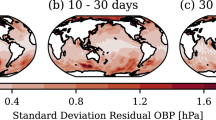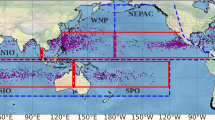Abstract
Within a theoretical ENSO model, the authors investigated whether or not the errors superimposed on model parameters could cause a significant “spring predictability barrier” (SPB) for El Niño events. First, sensitivity experiments were respectively performed to the air-sea coupling parameter, α and the thermocline effect coefficient µ. The results showed that the uncertainties superimposed on each of the two parameters did not exhibit an obvious season-dependent evolution; furthermore, the uncertainties caused a very small prediction error and consequently failed to yield a significant SPB. Subsequently, the conditional nonlinear optimal perturbation (CNOP) approach was used to study the effect of the optimal mode (CNOP-P) of the uncertainties of the two parameters on the SPB and to demonstrate that the CNOP-P errors neither presented a unified season-dependent evolution for different El Niño events nor caused a large prediction error, and therefore did not cause a significant SPB. The parameter errors played only a trivial role in yielding a significant SPB. To further validate this conclusion, the authors investigated the effect of the optimal combined mode (i.e. CNOP error) of initial and model errors on SPB. The results illustrated that the CNOP errors tended to have a significant season-dependent evolution, with the largest error growth rate in the spring, and yielded a large prediction error, inducing a significant SPB. The inference, therefore, is that initial errors, rather than model parameter errors, may be the dominant source of uncertainties that cause a significant SPB for El Niño events. These results indicate that the ability to forecast ENSO could be greatly increased by improving the initialization of the forecast model.
Similar content being viewed by others

References
Chen, D., M. A. Cane, A. Kaplan, S. E. Zebiak, and D. J. Huang, 2004: Predictability of El Niño over the past 148 years. Nature, 428, 733–736.
Duan, W. S., 2003: Applications of nonlinear optimization method to the studies of ENSO predictability. Ph. D. dissertation, Institute of Atmospheric Physics, Chinese Academy of Sciences, 111pp. (in Chinese)
Duan, W. S., M. Mu, and B. Wang, 2004: Conditional nonlinear optimal perturbation as the optimal precursors for ENSO events. J. Geophys. Res., 109, D23105.
Duan, W. S., X. Liu, K. Y. Zhu, and M. Mu, 2009: Exploring initial errors that cause a significant spring predictability barrier for El Niño events. J. Geophys. Res., 114, C04022, doi: 10.1029/2008JC004925.
Flügel, M., and P. Chang, 1998: Does the predictability of ENSO depend on the seasonal cycle? J. Atmos. Sci., 55, 3230–3243.
Garay, J. Z., 2004: Influence of stochastic forcing on ENSO prediction. J. Geophys. Res., 109, C1107.
Jin, E. K., and Coauthors, 2008: Current status of ENSO prediction skill in coupled ocean-atmosphere models. Climate Dyn., 31, 647–664.
Latif, M., and Coauthors, 1998: A review of the predictability and prediction of ENSO. J. Geophys. Res., 103, 14357–14393.
Liu, Z. Y., 2002: A simple model study of ENSO suppression by external periodic forcing. J. Atmos. Sci., 15, 1088–1098.
Moore, A. M., and R. Kleeman, 1996: The dynamics of error growth and predictability in a coupled model of ENSO. Quart. J. Roy. Meteor. Soc., 122, 1405–1446.
Mu, M., W. S. Duan, and J. C. Wang, 2002: Predictability problems in numerical weather and climate prediction. Adv. Atmos. Sci., 19, 191–205.
Mu, M., W. S. Duan, and B. Wang, 2003: Conditional nonlinear optimal perturbation and its applications. Nonlinear Processes in Geophysics, 10, 493–501.
Mu, M., W. S. Duan, and B. Wang, 2007a: Seasondependent dynamics of nonlinear optimal error growth and El Niño-Southern Oscillation predictability in a theoretical model. J. Geophys. Res., 112, D10113, doi: 10.1029/2005JD006981.
Mu, M., H. Xu, and W. S. Duan, 2007b: A kind of initial errors related to “spring predictability barrier” for El Niño events in Zebiak-Cane model. Geophys. Res. Lett., 34, L03709, doi: 10.1029/2006GL-27412.
Mu, M., W. S. Duan, Q. Wang, and Y. M. Liu, 2010: An extension of conditional nonlinear optimal perturbation. Nonlinear Processes in Geophysics, 17, 211–220.
Samelson, R. G., and E. Tziperman, 2001: Instability of the chaotic ENSO: The growth-phase predictability barrier. J. Atmos. Sci., 58, 3613–3625.
Tang, Y., Z. Deng, X. Zhou, Y. Cheng, and D. Chen, 2008: Interdecadal variation of ENSO predictability in multiple models. J. Climate, 21, 4811–4833.
Wang, B., and Z. Fang, 1996: Chaotic oscillation of tropical climate: A dynamic system theory for ENSO. J. Atmos. Sci., 53, 2786–2802.
Wang, C., and J. Picaut, 2004: Understanding ENSO physics—A review. Earth Climate: The Ocean-Atmosphere Interaction, Geophysical Monograph Series, Vol. 147, American Geophysical Union, 21–48.
Webster, P. J., and S. Yang, 1992: Monsoon and ENSO: Selectively interactive systems. Quart. J. Roy. Meteor. Soc., 118, 877–926.
William, P. D., 2005: Modelling climate change: the role of unresolved processes. Philosophical Transactions of the Roual Society, 363, 2931–2946.
Wu, D. H., and D. L. Anderson, 1993: ENSO variability and external impacts. J. Climate, 6, 1703–1717.
Yu, Y. S., W. S. Duan, H. Xu, and M. Mu, 2009: Dynamics of nonlinear error growth and seasondependent predictability of El Niño events in the Zebiak-Cane model. Quart. J. Roy. Meteor. Soc., doi: 10.1002/qj.526.
Zebiak, S. E., and M. A. Cane, 1987: A model El Niño Southern Oscillation. Mon. Wea. Rev., 115, 2262–2278.
Zhang, L., M. Flugel, and P. Chang, 2003: Testing the stochastic mechanism for low-frequency variations in ENSO predictability. Geophys. Res. Lett., 12, doi: 10.1029/2003GL017505.
Zheng, F., H. Wang, and J. Zhu, 2009: ENSO ensemble prediction: initial condition perturbations vs. model parameter perturbations. Chinese Science Bulletin, 54(14), 2516–2523.
Author information
Authors and Affiliations
Corresponding author
Rights and permissions
About this article
Cite this article
Duan, W., Zhang, R. Is model parameter error related to a significant spring predictability barrier for El Niño events? Results from a theoretical model. Adv. Atmos. Sci. 27, 1003–1013 (2010). https://doi.org/10.1007/s00376-009-9166-4
Received:
Revised:
Published:
Issue Date:
DOI: https://doi.org/10.1007/s00376-009-9166-4



